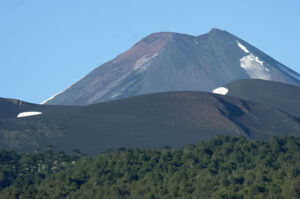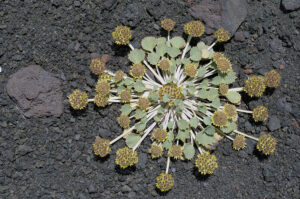Kaj Halberg - writer & photographer
Travels ‐ Landscapes ‐ Wildlife ‐ People
Chile 2011: The white forest
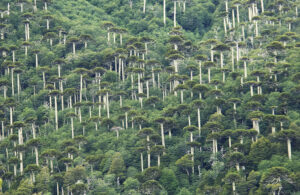
Near the park, we make a stop to stroll across an old lava stream, which stems from a volcanic eruption in 1957. Far away, the pointed, snow-clad peak of the Llaima Volcano (3125 m) seems to pierce the sky. The only vegetation among the lava rocks are a species of wintergreen, Gaultheria pumila, and numerous lichens.
In agricultural areas around the lava stream, we encounter several well-known plant species, including yarrow (Achillea millefolium), bull thistle (Cirsium vulgare), viper’s bugloss (Echium vulgare), common St. John’s wort (Hypericum perforatum), and ox-eye daisy (Leucanthemum vulgare). Presumably, their seeds were accidentally brought to this area by European settlers.
Bird life, however, is typically Chilean. We observe black-faced ibis (Theristicus melanopis), southern lapwing (Vanellus chilensis), long-tailed meadowlark (Leistes loyca, previously Sturnella loyca), Chimango caracara (Milvago chimango), and others.
We find a fine camping spot in an open forest, close to a gravel pit. At dusk, the owner appears – a friendly and talkative man, who is not at all opposed to our intention of camping in his forest. He informs us that it has been raining more or less continuously for the last week, and that today is the first fine summer’s day. The evening is pleasantly warm – at 9:30 p.m., our thermometer shows 26oC.

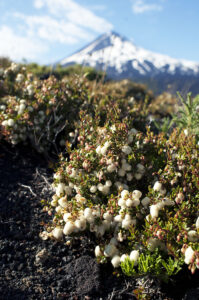
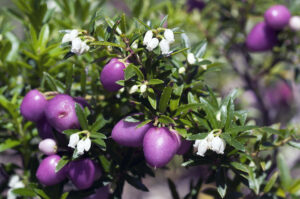
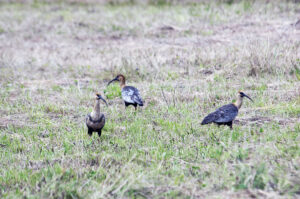
On the lake surface, several bird species are swimming about, including flying steamer duck (Tachyeres patachonicus), Chilean pintail (Anas georgica ssp. spinicauda), Andean duck (Oxyura ferruginea), and white-winged coot (Fulica leucoptera). On the shore, a pair of ashy-headed goose (Chloephaga poliocephala) are walking about with their goslings.
Rocks around the lake are home to various lizard species, the commonest of which is the painted tree lizard (Liolaemus pictus).

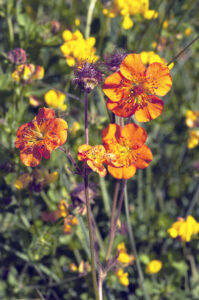

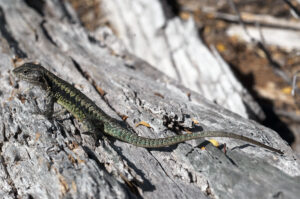
Around our camping spot, thousands of golden and yellow Inca lilies (Alstroemeria aurea) are flowering, and several white-throated treerunners (Pygarrhichas albogularis) are feeding on the tree trunks, nuthatch-like.
In the park, we encounter many other blooming plants, including Rhodophiala advena, a gorgeous member of the amaryllis family (Amaryllidaceae), a yellow-flowered orchid, Gavilea lutea, and the red-flowered Chilean firebush (Embothrium coccineum), a member of the family Proteaceae. The name of this family is based on the genus Protea, applied in 1767 by Swedish naturalist Carl Linnaeus (1707-1778) in reference to Proteus, a Greek deity who was able to change between many forms – an appropriate choice, as the family is known for its astonishing variety and diversity of flowers and leaves.
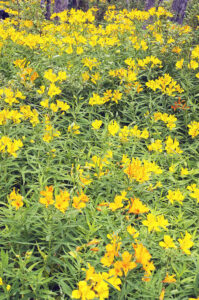
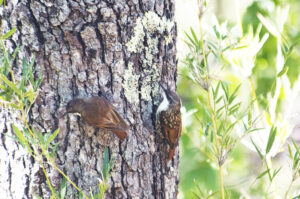
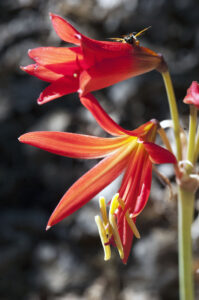
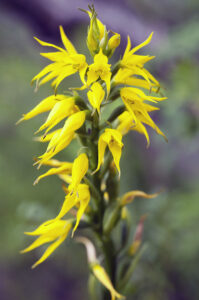
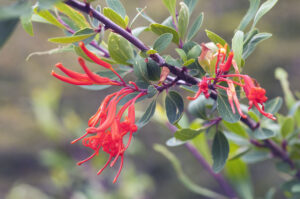
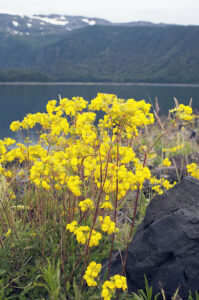
In 1791-1795, Scottish naturalist Archibald Menzies (1754-1842) participated as surgeon and botanist in an expedition around the world on board HMS Discovery, under leadership of Captain George Vancouver (1757-1798).
In Chile, while dining with the Viceroy, Menzies was served Araucaria seeds as a dessert. He popped some seeds into his pocket and was able to make them sprout on board the ship. He returned to England with five healthy plants – the first of its kind in Britain. (Source: kew.org)
The English name originates from around 1850. In an English park, which had specimens of this tree, a visitor jokingly remarked that it would “puzzle a monkey to climb that tree” – referring to its stiff, spiny leaves. The name monkey-puzzle tree stuck to this day.
The genus Araucaria belongs to an ancient group of conifers, which evolved in an era, before the ancient continent Gondwanaland began to separate. In those days, the distribution of Araucaria was limited to what is presently the southern hemisphere, and today members of the genus are found in South America, Australia, New Zealand, Norfolk Island, and New Caledonia.
The leaves of pehuén are triangular, 3-4 cm long and up to 3 cm broad at the base, very tough and with a sharp point. They can remain on the tree for as long as 15 years, and in time they cover the entire surface of younger branches, only the trunk and old branches being bare.
Araucaria species are usually dioecious, with male and female cones on separate trees. The female cones are wind-pollinated, in pehuén maturing in about 18 months. The mature cones are very large, 12-20 cm diameter, holding about 200 seeds, each 3-4 cm long. The edible, nut-like seeds are extensively harvested in Chile.
The specific name araucana was derived from the name of a local people, the Araucanians, who ate the seeds. A sub-group of this people are the Pehuenches. In the local language, pehuén is the name of the monkey-puzzle tree, whereas che means ’people’. (Source: en.wikipedia.org/wiki/Araucaria_araucana)
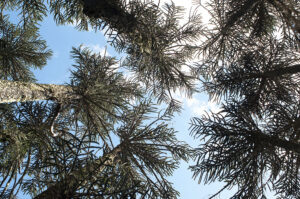
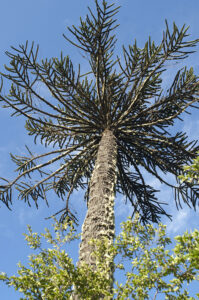
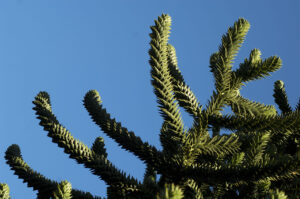
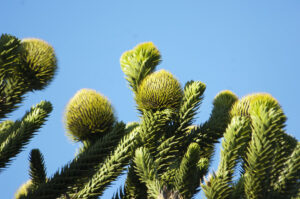
Birdlife in this forest is not particularly rich. We observe two species of woodpecker, the very large Magellanic woodpecker (Campephilus magellanicus) and Chilean flicker (Colaptes pitius), common miner (Geositta cunicularia), rufous-collared sparrow (Zonotrichia capensis), scale-throated earthcreeper (Upucerthia dumetaria), and small flocks of slender-billed parakeet (Enicognathus leptorhynchus).

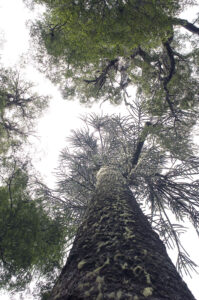

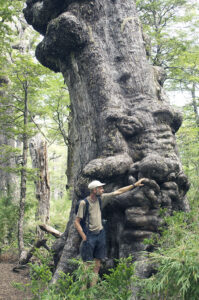
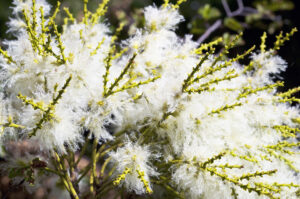
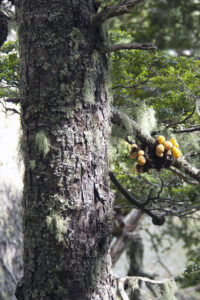
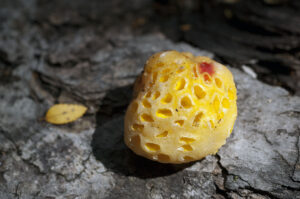

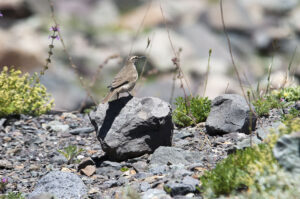
Vegetation along the upper part of the ridge consists of low shrubs of a different species of southern beech, Nothofagus alpina. Ultimately, these shrubs disappear, and we encounter the first snow.
Along a stream of meltwater, we encounter a group of Ourisia ruellioides, whose bright red flowers add a splash of colour to the drab landscape. This beautiful plant, previously known as O. poeppigii, is restricted to central and southern Chile and southern Argentina. Presumably, the specific name refers to the likeness of this species to members of the genus Ruellia, of the family Acanthaceae. This genus was named for French herbalist and physician Jean Ruel (1474-1537), also known as Jean Ruelle, or in Latin Ioannes Ruellius, who is best known for his publication of De Natura Stirpium (1536), a treatise on botany. The obsolete specific name was given in honour of German botanist, zoologist, and explorer Eduard Friedrich Poeppig (1798-1868), who spent several years exploring Chile, Peru, and Brazil. The results were publish in two volumes, titled Reise in Chile, Peru und auf dem Amazonenstrome, während der Jahre 1827-1832.
In a grassy area, we observe many other flowers, including fleabane (Erigeron), chickweed (Cerastium), a compact species of violet, Viola cotyledon, and the gorgeous Rhodolirium andicola, another member of the amaryllis family. At this altitude, we observe very few birds, only a flock of yellow-bridled finches (Melanodera xanthogramma), feeding in the grass.
Here and there, the melting snow has created ice caves, in which the walls and ’loft’ form a picturesque frame around nearby peaks in the Sierra Nevada.
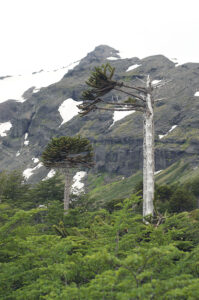
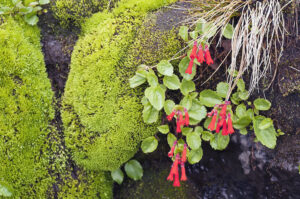
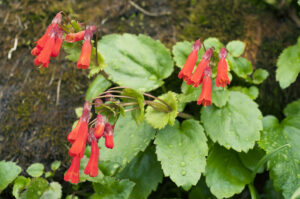
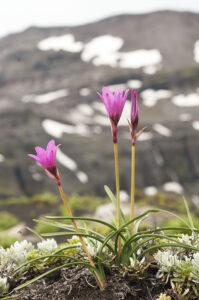
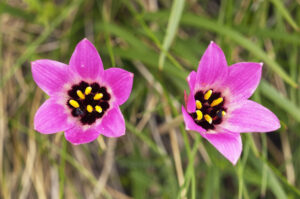


We fail to observe any animals.
